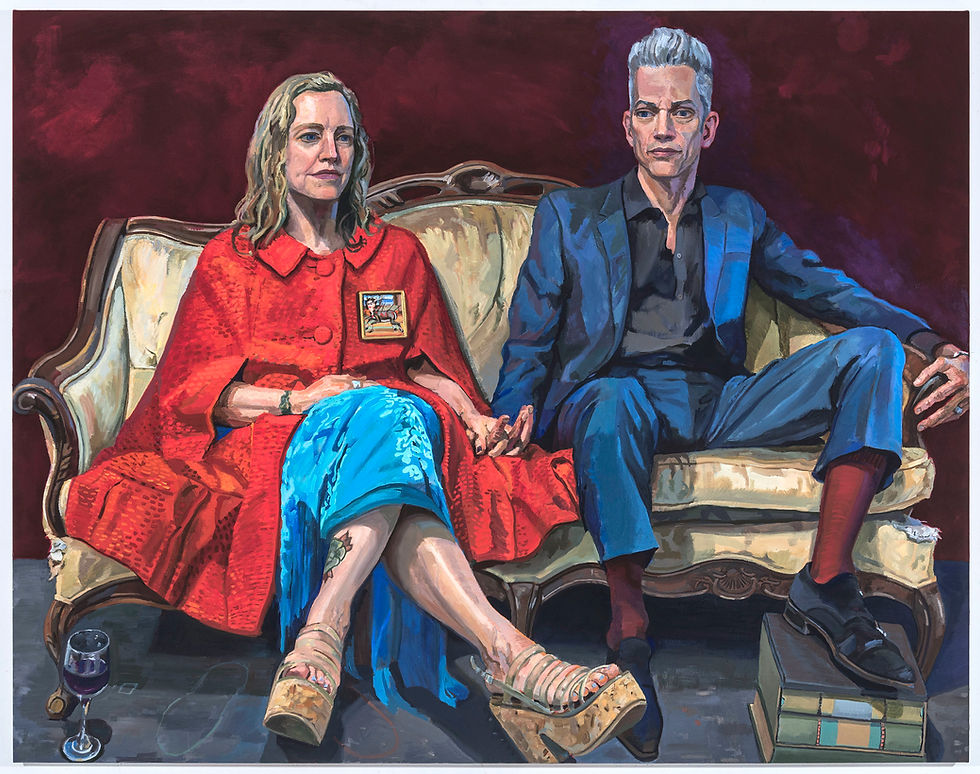Doug Young
- johnwilliammitchel
- Mar 9, 2022
- 3 min read
Updated: Sep 28, 2023
Brooklyn, NY | by John Mitchell
November 22, 2016
Doug Young lives and works in Bushwick, Brooklyn where he shares a work/live loft with his wife Tamsen and their two cats Grissom and Mohawk. Doug currently has a sculpture titled “Chains” installed at Van Doren Waxter Gallery in NYC through January 7, 2017 and an exhibition titled “General Dynamics” at the Lodge Gallery in NYC opening November 16 and running through December 23, 2016.
John Mitchell: How is what you were doing in 2014 through now different from what you were doing in 2010–2013?
Doug Young: From 2010 to 2013 I was working to understand the medium of reverse painting on glass. I taught myself how to be proficient with a new method of paint application and worked through different subject matters to find a marriage between the medium and the message.
After a show I had at the Lodge Gallery in 2013, which was essentially a survey of this time period, I wanted to create a more focused body of work driven by more timely content. The subjects are still universal but the content has become singular. This singularity is the tumultuous imbalance of our political and social climate. My new work has a more ominous tone.
With this new work, I also introduced a new element–the use of textiles, specifically the craft of rug hooking. I have made a couple of hooked rugs over the years and I wanted to introduce the technique into my paintings for two reasons. One, it compliments how I have always integrated folk art traditions and two; the textures create another level of engagement and questioning. I wanted to know if I could get opposing materials to coexist on the same plane.
JM: What prompted the move away from painting on stretched canvas with brushes and oil paint to using an airbrush and automotive paint to make reverse paintings on glass?
DY: Traditional painting, for me, is an action based on gesture and romance. It is an outcome that results from a long-awaited surge of energy after I have muddled through problems. It is very organic. The physicality of oil painting involves manipulating dirt, in a literal sense. Space and light are articulated directly through the artist’s hand. All form services the content. These are the processes of creation where a devotion to the material is paramount to accomplishing anything of lasting value.
I don’t believe I ever had that devotion.
What I am doing now could be described as painting, however it holds none of the values I just listed. This process has it’s own hierarchy. Reverse painting on glass cannot abide sweeping gesture, but requires slow advance. There is no moment when one stroke brings it all together, but rather many hours of careful plotting and strategy. These works are constructed with elements cut and joined just so. The surface coating is applied via a machine that does only one thing; it blows air. Yes, it can be controlled and manipulated, but not by typical strokes. The stroke is a painter’s tool, and one to be respected. But the tools I use now are knives and adhesives. Cutting and assembling is what I do and it resonates with what I did as a sculptor. This process has a beginning, middle, and an end, which is the opposite of the idea of the painter’s stopping point, never.
JM: You have said a reverse painting on glass that you saw in a flea market inspired you, but can you say more about other historical precedents? And does your work contribute to the tradition that you’ve inherited?
DY: The painting I found at the flea market touched on my folk art ‘nerve’. I am moved by a romantic notion of obsessive making that can be seen in certain areas of folk art. For example, there is a long history of ‘tramp art’ made by traveling men who would pass endless hours fanatically whittling an object from found wood. A more specific example of obsessive making that amazes me is the model-sized Empire State Building at the American Folk Art Museum. It is made from thousands of pieces of interlocking wood, simply incredible.
I see parallels in my own work through ideas of futility, marking existence with a knife’s edge. Painting on the reverse of glass operates in the same family — a careful, respectful manipulation of a material to surprising affect. While the materials are humble and approachable, making us think ‘I could do that’ — the actual method required to create a result that is so over-the-top, quickly turns the experience to one of sheer amazement at the feat, at the determination, and at the skill required. How does one make a linked chain out of wood? How does one play the banjo for twenty-four hours? How does one paint on glass?


















Comments